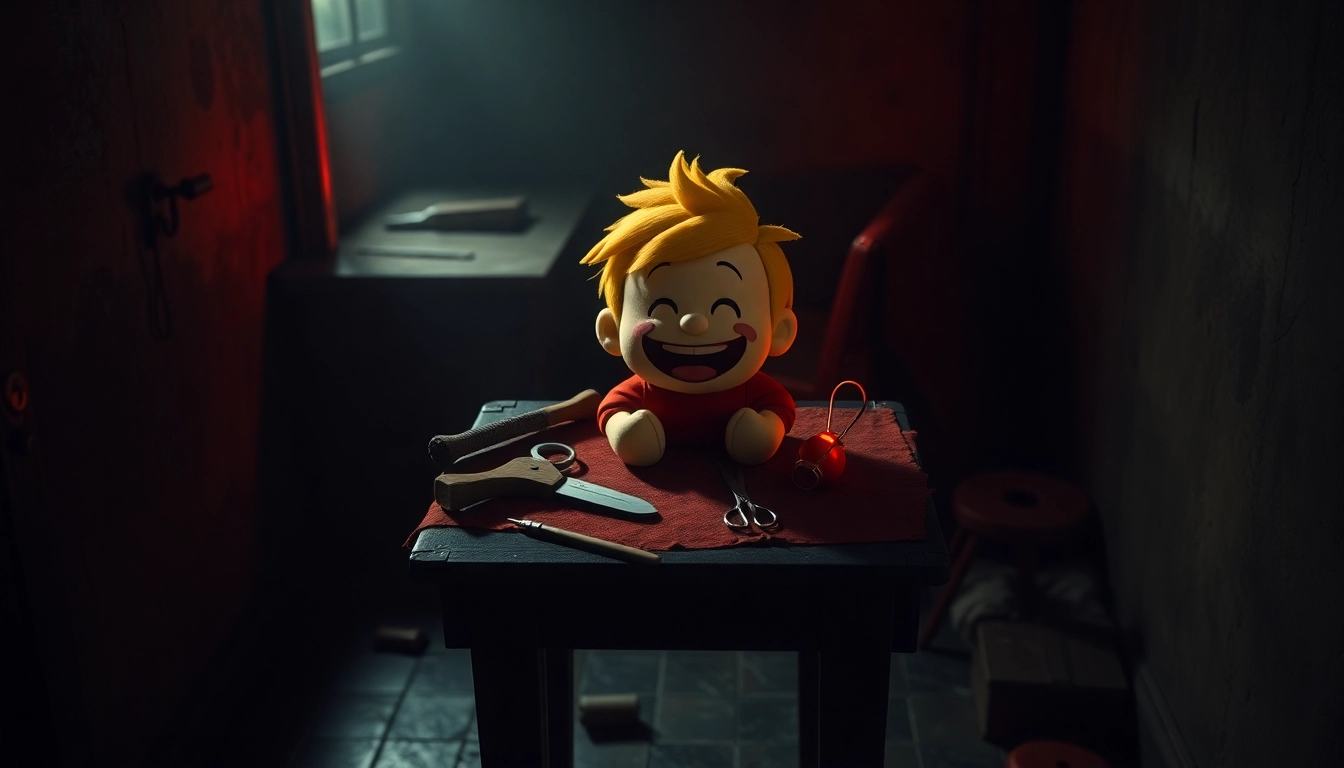Overview and Context of BLOODMONEY: A Dark Psychological Clicker Experience
In the realm of psychological horror games, blood money stands out as an intense, morally challenging experience that pushes players to confront their own boundaries of ethics and survival. Unlike traditional horror titles that rely purely on jump scares or grotesque visuals, BLOODMONEY immerses players in a disturbing narrative where each click not only earns money but also deepens Harvey’s suffering and moral decay. This game masterfully combines clicker mechanics with a dark, unsettling storyline, making it a unique addition to the horror genre. Its core premise revolves around a desperate individual diagnosed with a severe medical condition, desperately needing $25,000 for treatment. Faced with limited options, the player is introduced to Harvey—an innocuous, cheerful character who makes an offer that seems simple at first but becomes increasingly sinister as the game progresses.
Game Mechanics and Core Gameplay Elements
Clicking Mechanics and Earning Money
At the heart of BLOODMONEY is its clicker gameplay, where each click on Harvey generates a fixed amount of money—initially one dollar per click. This mechanic is deceptively simple but becomes profoundly unsettling as the game’s tone shifts. The more the player clicks, the more Harvey endures pain and suffering, visually and psychologically. As your funds grow, so does the intensity of Harvey’s reactions, which range from subtle discomfort to outright agony. This duality creates a tension that questions the morality of relentless pursuit of profit at any cost. The game’s design cleverly uses visual cues and Harvey’s dialogue to subtly hint at his increasing distress, making players feel the weight of their choices.
Upgrade System and Multiple Pathways
To accelerate earnings, players can purchase upgrades from the shop, which offer more effective but increasingly disturbing tools—needles, hammers, knives, and other violent implements. Each upgrade not only boosts profit but also impacts Harvey’s suffering and visual appearance, emphasizing the risk-reward dynamic. Notably, these upgrades open multiple pathways for gameplay, allowing players to choose between minimizing harm or maximizing efficiency regardless of the human cost. For instance, opting for a gentle approach with minimal upgrades results in fewer visual distortions and Harvey’s reactions, leading to a different ending than when using violent tools for maximum profit. The game subtly tracks these choices, influencing the eventual outcome.
The Dark Narrative of BLOODMONEY and Its Themes
The Moral Dilemma and Psychological Horror
Bloodmoney immerses players in a haunting psychological landscape, where every click symbolizes a moral compromise. The narrative explores themes of desperation, human depravity, and the duality of human nature. The central dilemma is stark: how much suffering are you willing to inflict on Harvey to reach your financial goal? The game’s unsettling atmosphere intensifies as Harvey’s cheerful demeanor gradually deteriorates, replaced by fear and pain. Visual cues—such as Harvey’s changing facial expressions, trembling, or tears—serve as visceral reminders of the moral cost. The game’s psychological horror stems from its ability to evoke genuine empathy and discomfort, making players question whether survival justifies such moral transgressions.
Time Pressure and Urgency
The ticking clock to raise $25,000 adds to the game’s tension. Your medical bills are overdue, and every moment that passes heightens the urgency. This time pressure forces players into difficult decisions, balancing speed versus morality. Do you click furiously, risking Harvey’s increased suffering, or do you pace yourself, risking failure to meet the deadline? This element reinforces the game’s core message: survival often comes at a moral price, and the choices are rarely black and white.
Multiple Endings: The Moral Spectrum
One of BLOODMONEY’s most compelling features is its multiple endings, which reflect the player’s moral stance. These include:
- The Good Ending: Achieved by minimizing Harvey’s suffering, often using the least violent tools, and maintaining a sense of empathy.
- The Normal Ending: A balanced approach where some violence is used to expedite earnings, but without maximizing harm.
- The Bad Ending: The result of relentless use of violent upgrades, maximizing Harvey’s pain regardless of morality.
Each ending offers a different perspective on morality and survival, prompting players to reflect on their choices and the implications of their actions.
Harvey: Innocence Versus Suffering
The Role of Harvey as a Symbol
Harvey appears as a cheerful, innocent character who initially seems oblivious to the darker implications of the game’s shop offerings. His surprise at more violent tools—like hammers or knives—suggests he may not fully understand what’s happening, adding a layer of moral ambiguity. This innocence contrasted with the sinister nature of the upgrades underscores the game’s exploration of human morality: is Harvey truly suffering, or is he a symbol of innocence caught in a cruel game? Observant players have noted that Harvey’s reactions become increasingly distressed, with visual cues such as tears, trembling, or fearful expressions, heightening the emotional impact.
Harvey’s Reactions and Emotional Impact
The game employs subtle visual and auditory cues to communicate Harvey’s pain. For example, his facial expressions change, his voice may quiver, and visual distortions are used to evoke discomfort. The emotional design aims to make players feel guilt and empathy, even as they are compelled to continue clicking. The emotional toll is so potent that many players report feeling genuinely disturbed, highlighting the game’s success in blending gameplay with psychological storytelling.
Upgrades and Their Impact on Morality
Tools and Their Visual and Psychological Consequences
The shop offers a range of upgrades, each with increasing levels of violence. Starting with harmless items like pillows or gentle needles, players can progress to hammers, knives, and other brutal implements. These tools significantly boost earnings but also escalate Harvey’s suffering. The game’s design thoughtfully integrates the impact of these choices—visual cues such as Harvey’s facial distortion, trembling, or tears become more pronounced with violent upgrades. Psychologically, players are forced to confront their own thresholds: is more profit worth the moral cost?
Hidden Depths and Player Discovery
Interestingly, players have observed that Harvey sometimes reacts with surprise or confusion when new, more violent tools are introduced. His reactions imply he may not fully understand what’s in the shop, which adds complexity to the moral dynamic. For instance, Harvey’s initial expectation of harmless items like pillows for “pillow fights” juxtaposes starkly with the violent tools now available. This subtle detail deepens the narrative, suggesting a dissonance between appearance and reality, and challenges players to consider the ethical implications of their actions.
Player Choices and Their Consequences
Strategies for Achieving Endings
While it’s possible to reach the different endings through various strategies, some nuances influence the final outcome. For example, using the hammer may seem to push players toward the Bad Ending, but with careful restraint, the Good Ending is still attainable. Conversely, choosing scissors often leads to the Normal Ending, providing a middle ground. The game subtly tracks your behavior—how often you click, which upgrades you buy, and Harvey’s reactions—making each playthrough a unique moral journey. The emotional impact of these choices is profound; even players who deliberately minimize violence report feeling a deep sense of guilt or discomfort.
Emotional Responses and Reflection
One striking aspect of BLOODMONEY is its ability to evoke genuine emotional reactions. For instance, players have reported freezing when Harvey reacts painfully to a needle, feeling a surge of empathy and guilt. This emotional engagement underscores the game’s success in blending gameplay with psychological storytelling. It prompts reflection on real-world dilemmas—how far would we go for survival? Is profit worth the moral cost? The game’s design ensures that these questions linger long after gameplay ends.
Visual and Atmospheric Cues That Amplify Unsettling Atmosphere
Subtle Visual Distortions and Dialogue
The game excels at creating an increasingly disturbing atmosphere through visual cues. Harvey’s facial expressions become more distressed, and visual distortions occur as he endures pain. Dialogue also shifts from cheerful to fearful, further immersing players in the psychological horror. These elements work together to evoke a visceral response, making the moral choices feel genuinely impactful. The gradual deterioration of Harvey’s appearance and demeanor mirrors the player’s descent into moral ambiguity, intensifying the emotional stakes.
Sound Design and Emotional Impact
Complementing the visuals is an unsettling soundscape, with muffled cries, trembling voices, and dissonant background music that heighten tension. The combination of visual and auditory cues creates a deeply immersive experience, forcing players to confront uncomfortable truths about human nature and survival.
Community Insights and Player Experiences
Shared Discoveries and Moral Debates
The BLOODMONEY community is vibrant, with players sharing their experiences, strategies, and moral reflections. Many have noted that Harvey’s reactions sometimes seem genuine, prompting emotional responses ranging from guilt to empathy. Discussions often revolve around whether it’s possible to achieve the Good Ending without resorting to violence, and what the game suggests about human morality. Some players have even expressed that the game made them question their own ethics outside of gameplay, illustrating its profound psychological impact.
Notable Playthroughs and Video Analysis
Featured gameplay videos provide detailed breakdowns of strategies and emotional responses. These analyses highlight how subtle choices—such as the timing and type of upgrades—can dramatically alter the ending. Video content often emphasizes the emotional weight of Harvey’s reactions, reinforcing the game’s themes of moral decay and survival.
Thematic Depth: Humanity and Survival in BLOODMONEY
The Duality of Human Nature
Bloodmoney brilliantly captures the duality of human nature—innocence versus depravity—by contrasting Harvey’s cheerful persona with the dark, violent tools available in the shop. The game questions whether humans are inherently good or evil when faced with extreme circumstances. Harvey symbolizes innocence and hope, while the shop represents the darker forces that tempt players toward moral compromise. This dichotomy invites players to reflect on their own values and what they might do in similar situations.
Survival at What Cost?
The core moral question remains: how far are you willing to go for survival? The game doesn’t provide easy answers, instead forcing players to confront their own limits. Each decision, from minimal harm to maximum efficiency, shapes the narrative and reveals the player’s moral stance. The multiple endings serve as a mirror, reflecting the choices made and their consequences, emphasizing that survival often comes with a moral price.
Comparative Analysis: BLOODMONEY and Other Psychological Horror Games
While BLOODMONEY shares themes with other psychological horror titles—such as emotional manipulation, moral dilemmas, and disturbing visuals—it distinguishes itself through its clicker mechanics and moral complexity. Unlike traditional horror games that rely on jump scares, BLOODMONEY immerses players in a slow, visceral experience that explores the depths of human depravity. Its focus on choice and consequence, combined with subtle visual cues and emotional storytelling, sets it apart as a thought-provoking title that challenges players’ ethics.
Conclusion: How Far Are You Willing to Go for Survival?
Bloodmoney presents a haunting question wrapped in a disturbing gameplay experience: what is the true cost of survival? The game’s innovative mechanics, emotional depth, and moral ambiguity compel players to examine their own boundaries. Will you choose the path of minimal harm, or will you maximize profit at any human expense? The decision ultimately determines your fate and the ending you receive. As you navigate this dark journey, remember that every click echoes with moral weight, testing how far you are willing to go when your life hangs in the balance.
For those intrigued by this unsettling exploration of morality and survival, delve deeper into the world of blood money. Its provocative narrative and challenging gameplay will leave lasting impressions and provoke ongoing reflection about the human condition.
Connect With Us
Join the community of players and fans who are exploring the depths of BLOODMONEY. Share your experiences, theories, and moral reflections, and stay tuned for more insights into this dark, psychological universe. Whether you’re a seasoned player or new to the experience, the game’s unsettling world awaits your choices. How far are you willing to go for survival? The answer lies in your actions, and your story is yet to be written.









